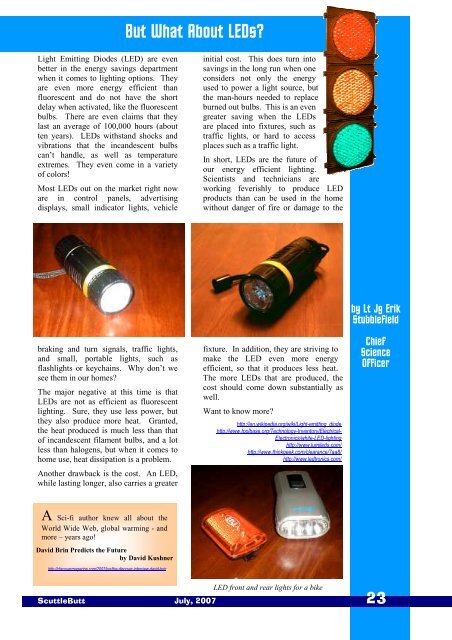ScuttleButt - USS Southern Cross
ScuttleButt - USS Southern Cross
ScuttleButt - USS Southern Cross
Create successful ePaper yourself
Turn your PDF publications into a flip-book with our unique Google optimized e-Paper software.
But What About LEDs<br />
Light Emitting Diodes (LED) are even<br />
better in the energy savings department<br />
when it comes to lighting options. They<br />
are even more energy efficient than<br />
fluorescent and do not have the short<br />
delay when activated, like the fluorescent<br />
bulbs. There are even claims that they<br />
last an average of 100,000 hours (about<br />
ten years). LEDs withstand shocks and<br />
vibrations that the incandescent bulbs<br />
can’t handle, as well as temperature<br />
extremes. They even come in a variety<br />
of colors!<br />
Most LEDs out on the market right now<br />
are in control panels, advertising<br />
displays, small indicator lights, vehicle<br />
initial cost. This does turn into<br />
savings in the long run when one<br />
considers not only the energy<br />
used to power a light source, but<br />
the man-hours needed to replace<br />
burned out bulbs. This is an even<br />
greater saving when the LEDs<br />
are placed into fixtures, such as<br />
traffic lights, or hard to access<br />
places such as a traffic light.<br />
In short, LEDs are the future of<br />
our energy efficient lighting.<br />
Scientists and technicians are<br />
working feverishly to produce LED<br />
products than can be used in the home<br />
without danger of fire or damage to the<br />
braking and turn signals, traffic lights,<br />
and small, portable lights, such as<br />
flashlights or keychains. Why don’t we<br />
see them in our homes<br />
The major negative at this time is that<br />
LEDs are not as efficient as fluorescent<br />
lighting. Sure, they use less power, but<br />
they also produce more heat. Granted,<br />
the heat produced is much less than that<br />
of incandescent filament bulbs, and a lot<br />
less than halogens, but when it comes to<br />
home use, heat dissipation is a problem.<br />
Another drawback is the cost. An LED,<br />
while lasting longer, also carries a greater<br />
fixture. In addition, they are striving to<br />
make the LED even more energy<br />
efficient, so that it produces less heat.<br />
The more LEDs that are produced, the<br />
cost should come down substantially as<br />
well.<br />
Want to know more<br />
http://en.wikipedia.org/wiki/Light-emitting_diode<br />
http://www.toolbase.org/Technology-Inventory/Electrical-<br />
Electronics/white-LED-lighting<br />
http://www.lumileds.com/<br />
http://www.thinkgeek.com/clearance/7aa8/<br />
http://www.ledtronics.com/<br />
by Lt Jg Erik<br />
Stubblefield<br />
Chief<br />
Science<br />
Officer<br />
A Sci-fi author knew all about the<br />
World Wide Web, global warming - and<br />
more – years ago!<br />
David Brin Predicts the Future<br />
by David Kushner<br />
http://discovermagazine.com/2007/jun/the-discover-interview-david-brin<br />
LED front and rear lights for a bike<br />
<strong>ScuttleButt</strong> July, 2007 23





